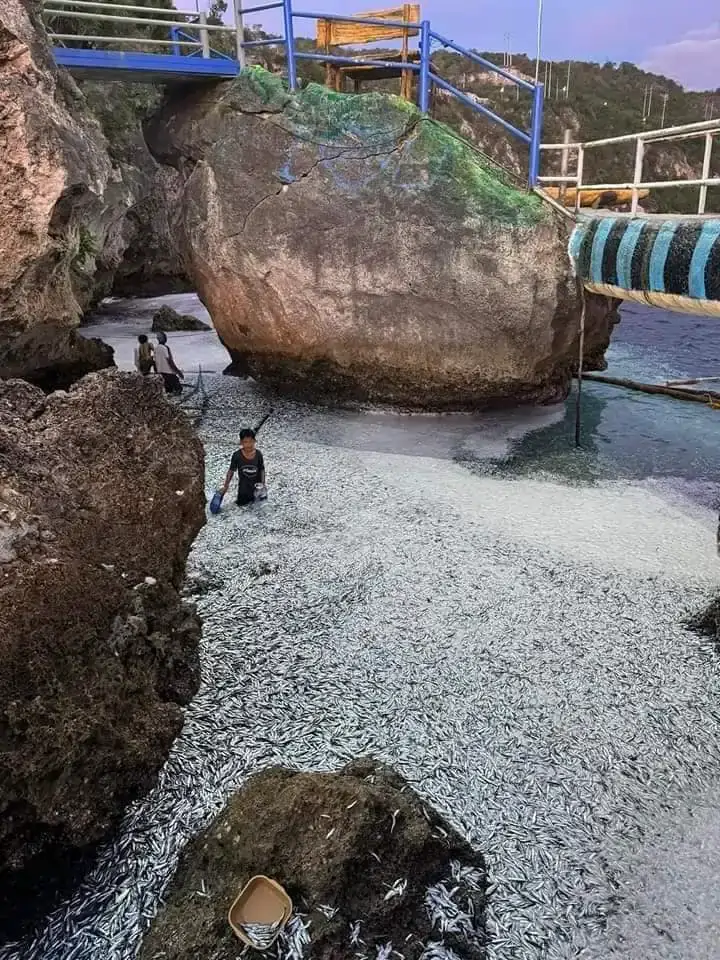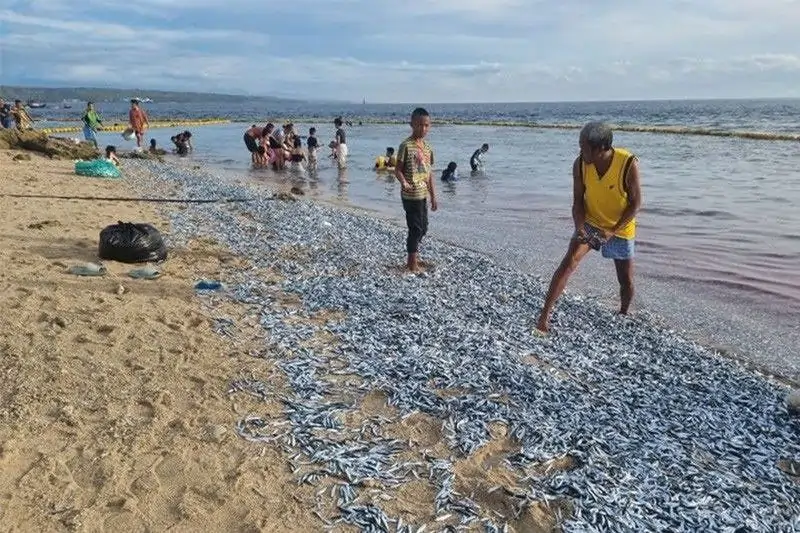Sardines beached in Sarangani
Sardines beached in Sarangani– The unexplained phenomenon of sardines beaching along the shores of Sarangani presents a complex puzzle with potential multifaceted explanations rooted in environmental dynamics.
Such events are often intricate and could stem from an interplay of various factors, necessitating a comprehensive investigation to unravel the underlying causes.
One possible contributing factor to the sardines beached in Sarangani is abrupt fluctuations in water temperature. Sardines, like many marine species, have a narrow range of temperature tolerance.
Spikes or drops in water temperature can disorient or stress these fish, potentially leading them to swim closer to the shoreline, inadvertently ending up stranded.
Furthermore, shifts in ocean currents might play a significant role in this occurrence. Sardines often move in large schools, following the flow of currents for migration or feeding purposes.
Alterations in these currents, whether due to natural phenomena or human-induced changes, could misdirect these schools toward shallower waters, leading to mass beaching.
Disturbances in their natural habitat also pose a plausible explanation. Pollution, habitat degradation, or alterations in water chemistry might disrupt the sardines’ usual behavior, driving them toward the coast in search of safer conditions. Factors like excessive pollutants or changes in salinity levels can compel these fish to seek refuge in areas they wouldn’t typically inhabit.
Scientific research and collaborative efforts involving marine biologists, environmentalists, and local authorities should be prioritized to comprehensively study the situation. Such investigations might involve assessing water quality, studying oceanographic data, and monitoring the behavioral patterns of sardines, aiming to piece together the puzzle and devise measures to mitigate or prevent future beaching events.
Preserving the delicate balance of marine ecosystems demands a concerted effort to comprehend and address such occurrences, ensuring the protection of not just sardines but the broader biodiversity of coastal regions like Sarangani.
Sardines beached in Sarangani: Several Possible reasons for this Phenomenon
Temperature Changes: Sardines beached in Sarangani are extremely sensitive to variations in water temperature because they are so attuned to it. These fish react immediately to abrupt changes or oscillations, running for cover from unfavorable circumstances.
These changes may cause them to deviate from their typical patterns of behavior and seek for shallower waters. Because they are naturally sensitive to changes in temperature, Sardines beached in Sarangani may unintentionally beach themselves in search of a more suited habitat. Mass beaching events can occur along the coastline as a result of this tendency, which was initially a survival technique.
The existence of a predator: Sardines’ behavior and migratory patterns are significantly impacted by the presence of larger predators in their habitat. As a prey species, sardines have developed complex survival mechanisms in reaction to threats from predators. When larger Understanding the intricate dynamics between predator-prey interactions and their influence on the movement of sardines is crucial.
It emphasizes the need for comprehensive ecological studies to assess the presence and behavior of predators in sardine habitats. Such insights could aid in predicting and potentially mitigating instances of mass beaching, ensuring the conservation of these species within their natural ecosystems. predators approach, sardines may feel that they are in immediate danger and begin to flee.
Environmental Factors: pollution and other environmental stressors pose a significant threat to sardine populations. Chemical pollutants or changes in water quality can interfere with their sensory perception and disrupt normal behavior.
This interference might lead sardines to behave erratically, potentially causing them to lose their usual navigation abilities and, ultimately, end up stranded along the coastline.
Marine life can be greatly impacted by variations in oxygen levels, which are frequently linked to a variety of anthropogenic and natural events. Sardines are distressed when there is not enough oxygen in the water, a condition called hypoxia, which makes them search for locations with more oxygen.
These fish run the risk of becoming stranded if they unintentionally drift toward shallower waters in their desperate attempt to survive, where oxygen levels may be more favorable.
Human Activities: Human activity has a substantial effect on marine ecosystems and can be a major factor in changing sardine behavior, which may lead to beaching incidents. Sardine populations can be harmed by fishing methods, especially those that use unsustainable or large-scale operations.
Their natural abundance may be diminished by overfishing, which may cause them to wander erratically in search of regions they believe to be safer. This may eventually cause them to relocate into shallower waters and beaches.
Sardines beached in Sarangani- The Department of Environment and Natural Resources-Soccsksargen’s Cirilo Aquadera Lagnason Jr. declaration offers important details about possible reasons of the sardine beaching event.
Their analysis casts doubt on several presumptions about the direct correlation between these events and geological events by specifically excluding any connections to submerged seismic activity like as earthquakes or tectonic movements.
This statement suggests a departure from the accepted wisdom that suggests widespread beaching could be an early warning indicator of seismic activity. It calls for a more nuanced analysis of these occurrences, emphasizing the complexity of marine ecosystems and the wide range of variables that may affect fish behavior.
This assertion calls for a more thorough investigation of environmental factors, even if seismic activity has historically been connected to large-scale beaching events in certain instances.
It emphasizes the necessity of thorough studies that include a wide range of topics, including predator behavior, temperature fluctuations, human influences, and water quality.
Lagnason Jr.’s observation doesn’t completely discount seismic activity; rather, it encourages a comprehensive analysis of all the variables involved. This change in viewpoint motivates experts and academics to look into a larger range of plausible explanations, which advances our knowledge of the complex systems underlying these fascinating and frequently puzzling events along the coasts.
Sardines beached in Sarangani: Conclusion
Sardines beached in Sarangani incidents are a clear reminder of the vulnerability of marine ecosystems and the numerous difficulties they encounter. Even though precise forecasts for these events may prove difficult to achieve, a number of factors influence their occurrence.
These fish may become lost due to natural occurrences like shifts in ocean currents or water temperature, leaving them stranded along the shorelines.
But these marine animals are also greatly impacted by human activities like overfishing, pollution, and habitat change, which may push them onto the coast in search of safety.
The key to addressing these incidents lies in a comprehensive approach that involves scientific research, environmental monitoring, and community engagement.
Understanding the complex interplay between natural processes and human influence is crucial in developing strategies for conservation and sustainable practices.
Initiatives focusing on reducing pollution, regulating fishing practices, and preserving marine habitats can help mitigate these events and protect the delicate balance of Sarangani Bay’s ecosystem.
These incidents should be seen as a call to action, motivating local government officials, researchers, communities, and legislators to work together to protect Sarangani Bay’s marine biodiversity.
We can work to reduce these upsetting occurrences and guarantee a healthy future for marine life in Sarangani Bay and beyond by developing a deeper knowledge of the causes at play and putting policies in place to encourage responsible care of these priceless ecosystems.
Sardines beached in Sarangani: Thoughts about Sarangani’s Sardine Beachings
The frequent sardines beached in Sarangani Bay prompt thoughtful contemplation on the complex interrelationship between the natural world and humankind.
These occurrences force us to consider the complex issues affecting marine ecosystems and our responsibility for their preservation.
Essentially, these Sardines beached in Sarangani are devastating reminders of how vulnerable marine life is.
They represent the fragile equilibrium found in these ecosystems, which is readily upset by alterations brought about by humans or by natural variations. Seeing events like these forces us to reflect more deeply on the effects of human activity on the environment, ranging from pollution to overfishing.
These events further highlight how interrelated all life forms are. Sardine beaching is a symptom of more significant environmental changes rather than just one isolated incident.
It draws attention to the way ecosystems are affected by ripples that impact not just sardines but the entire web of life that they inhabit.
These Sardines beached in Sarangani ought to spur preventative action in the face of these obstacles. They push for the adoption of sustainable practices and the preservation of marine environments, urging us to reevaluate our relationship with the oceans.
Moreover, these occurrences underscore the interconnectedness of all life forms. The Sardines beached in Sarangani isn’t merely an isolated event but a signal of broader environmental shifts. It highlights the ripple effects that reverberate through ecosystems, affecting not just the sardines but the entire web of life they are a part of.
To lessen and avoid such occurrences, cooperative efforts incorporating scientific research, community involvement, and legislative measures become essential.
In the face of these challenges, these Sardines beached in Sarangani should serve as a catalyst for proactive measures. They urge us to reassess our relationship with the oceans, prompting the implementation of sustainable practices and the conservation of marine habitats.
Collaborative efforts involving scientific research, community engagement, and policy initiatives become imperative to mitigate and prevent such events.
Ultimately, the sardines beached in Sarangani Bay beckon us to become responsible stewards of our planet. They challenge us to seek a harmonious coexistence with nature, where our actions respect the delicate balance of ecosystems.
As we reflect on these occurrences, it’s a poignant reminder of our duty to protect and preserve the oceans and their myriad inhabitants for future generations.







